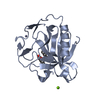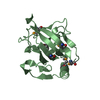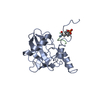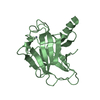+ Open data
Open data
- Basic information
Basic information
| Entry | Database: PDB / ID: 1fyw | ||||||
|---|---|---|---|---|---|---|---|
| Title | CRYSTAL STRUCTURE OF THE TIR DOMAIN OF HUMAN TLR2 | ||||||
 Components Components | TOLL-LIKE RECEPTOR 2 | ||||||
 Keywords Keywords |  SIGNALING PROTEIN / beta-alpha-beta fold parallel beta sheet / SIGNALING PROTEIN / beta-alpha-beta fold parallel beta sheet /  Structural Genomics / PSI / Structural Genomics / PSI /  Protein Structure Initiative / Northeast Structural Genomics Consortium / NESG Protein Structure Initiative / Northeast Structural Genomics Consortium / NESG | ||||||
| Function / homology |  Function and homology information Function and homology informationToll Like Receptor TLR6:TLR2 Cascade / triacyl lipopeptide binding / Toll-like receptor 2-Toll-like receptor 6 protein complex / detection of diacyl bacterial lipopeptide / toll-like receptor TLR6:TLR2 signaling pathway / cellular response to diacyl bacterial lipopeptide / Toll-like receptor 1-Toll-like receptor 2 protein complex / detection of triacyl bacterial lipopeptide / cellular response to triacyl bacterial lipopeptide / cellular response to bacterial lipopeptide ...Toll Like Receptor TLR6:TLR2 Cascade / triacyl lipopeptide binding / Toll-like receptor 2-Toll-like receptor 6 protein complex / detection of diacyl bacterial lipopeptide / toll-like receptor TLR6:TLR2 signaling pathway / cellular response to diacyl bacterial lipopeptide / Toll-like receptor 1-Toll-like receptor 2 protein complex / detection of triacyl bacterial lipopeptide / cellular response to triacyl bacterial lipopeptide / cellular response to bacterial lipopeptide / negative regulation of synapse assembly / positive regulation of cellular response to macrophage colony-stimulating factor stimulus / lipopolysaccharide immune receptor activity / Toll Like Receptor TLR1:TLR2 Cascade /  Beta defensins / toll-like receptor 2 signaling pathway / positive regulation of matrix metallopeptidase secretion / I-kappaB phosphorylation / nitric oxide metabolic process / Beta defensins / toll-like receptor 2 signaling pathway / positive regulation of matrix metallopeptidase secretion / I-kappaB phosphorylation / nitric oxide metabolic process /  central nervous system myelin formation / central nervous system myelin formation /  Toll-like receptor binding / positive regulation of interleukin-18 production / leukotriene metabolic process / Regulation of TLR by endogenous ligand / response to fatty acid / Toll-like receptor binding / positive regulation of interleukin-18 production / leukotriene metabolic process / Regulation of TLR by endogenous ligand / response to fatty acid /  peptidoglycan binding / NAD+ nucleotidase, cyclic ADP-ribose generating / NADP+ nucleosidase activity / microglia development / MyD88 deficiency (TLR2/4) / negative regulation of phagocytosis / peptidoglycan binding / NAD+ nucleotidase, cyclic ADP-ribose generating / NADP+ nucleosidase activity / microglia development / MyD88 deficiency (TLR2/4) / negative regulation of phagocytosis /  pattern recognition receptor activity / IRAK4 deficiency (TLR2/4) / MyD88:MAL(TIRAP) cascade initiated on plasma membrane / pattern recognition receptor activity / IRAK4 deficiency (TLR2/4) / MyD88:MAL(TIRAP) cascade initiated on plasma membrane /  toll-like receptor signaling pathway / positive regulation of oligodendrocyte differentiation / positive regulation of nitric-oxide synthase biosynthetic process / cellular response to lipoteichoic acid / positive regulation of interleukin-10 production / positive regulation of Wnt signaling pathway / positive regulation of chemokine production / positive regulation of interferon-beta production / positive regulation of interleukin-12 production / secretory granule membrane / response to progesterone / toll-like receptor signaling pathway / positive regulation of oligodendrocyte differentiation / positive regulation of nitric-oxide synthase biosynthetic process / cellular response to lipoteichoic acid / positive regulation of interleukin-10 production / positive regulation of Wnt signaling pathway / positive regulation of chemokine production / positive regulation of interferon-beta production / positive regulation of interleukin-12 production / secretory granule membrane / response to progesterone /  learning / cell projection / positive regulation of interleukin-8 production / learning / cell projection / positive regulation of interleukin-8 production /  lipopolysaccharide binding / microglial cell activation / response to insulin / response to toxic substance / positive regulation of inflammatory response / cellular response to type II interferon / positive regulation of interleukin-6 production / positive regulation of non-canonical NF-kappaB signal transduction / phagocytic vesicle membrane / Modulation by Mtb of host immune system / transmembrane signaling receptor activity / positive regulation of tumor necrosis factor production / lipopolysaccharide binding / microglial cell activation / response to insulin / response to toxic substance / positive regulation of inflammatory response / cellular response to type II interferon / positive regulation of interleukin-6 production / positive regulation of non-canonical NF-kappaB signal transduction / phagocytic vesicle membrane / Modulation by Mtb of host immune system / transmembrane signaling receptor activity / positive regulation of tumor necrosis factor production /  signaling receptor activity / signaling receptor activity /  cell body / cell body /  amyloid-beta binding / positive regulation of NF-kappaB transcription factor activity / ER-Phagosome pathway / defense response to virus / response to hypoxia / amyloid-beta binding / positive regulation of NF-kappaB transcription factor activity / ER-Phagosome pathway / defense response to virus / response to hypoxia /  receptor complex / defense response to Gram-positive bacterium / receptor complex / defense response to Gram-positive bacterium /  immune response / immune response /  inflammatory response / inflammatory response /  membrane raft / negative regulation of cell population proliferation / membrane raft / negative regulation of cell population proliferation /  innate immune response / apoptotic process / Neutrophil degranulation / protein-containing complex binding / positive regulation of gene expression / SARS-CoV-2 activates/modulates innate and adaptive immune responses / innate immune response / apoptotic process / Neutrophil degranulation / protein-containing complex binding / positive regulation of gene expression / SARS-CoV-2 activates/modulates innate and adaptive immune responses /  Golgi apparatus / Golgi apparatus /  cell surface / cell surface /  signal transduction / positive regulation of transcription by RNA polymerase II / identical protein binding / signal transduction / positive regulation of transcription by RNA polymerase II / identical protein binding /  plasma membrane / plasma membrane /  cytoplasm cytoplasmSimilarity search - Function | ||||||
| Biological species |   Homo sapiens (human) Homo sapiens (human) | ||||||
| Method |  X-RAY DIFFRACTION / X-RAY DIFFRACTION /  SYNCHROTRON / Resolution: 3 Å SYNCHROTRON / Resolution: 3 Å | ||||||
 Authors Authors | Xu, Y. / Tao, X. / Shen, B. / Horng, T. / Medzhitov, R. / Manley, J.L. / Tong, L. / Northeast Structural Genomics Consortium (NESG) | ||||||
 Citation Citation |  Journal: Nature / Year: 2000 Journal: Nature / Year: 2000Title: Structural basis for signal transduction by the Toll/interleukin-1 receptor domains. Authors: Xu, Y. / Tao, X. / Shen, B. / Horng, T. / Medzhitov, R. / Manley, J.L. / Tong, L. | ||||||
| History |
|
- Structure visualization
Structure visualization
| Structure viewer | Molecule:  Molmil Molmil Jmol/JSmol Jmol/JSmol |
|---|
- Downloads & links
Downloads & links
- Download
Download
| PDBx/mmCIF format |  1fyw.cif.gz 1fyw.cif.gz | 40.6 KB | Display |  PDBx/mmCIF format PDBx/mmCIF format |
|---|---|---|---|---|
| PDB format |  pdb1fyw.ent.gz pdb1fyw.ent.gz | 32.1 KB | Display |  PDB format PDB format |
| PDBx/mmJSON format |  1fyw.json.gz 1fyw.json.gz | Tree view |  PDBx/mmJSON format PDBx/mmJSON format | |
| Others |  Other downloads Other downloads |
-Validation report
| Arichive directory |  https://data.pdbj.org/pub/pdb/validation_reports/fy/1fyw https://data.pdbj.org/pub/pdb/validation_reports/fy/1fyw ftp://data.pdbj.org/pub/pdb/validation_reports/fy/1fyw ftp://data.pdbj.org/pub/pdb/validation_reports/fy/1fyw | HTTPS FTP |
|---|
-Related structure data
- Links
Links
- Assembly
Assembly
| Deposited unit | 
| ||||||||
|---|---|---|---|---|---|---|---|---|---|
| 1 |
| ||||||||
| 2 | 
| ||||||||
| Unit cell |
|
- Components
Components
| #1: Protein |  Mass: 18455.197 Da / Num. of mol.: 1 / Fragment: TIR DOMAIN Source method: isolated from a genetically manipulated source Source: (gene. exp.)   Homo sapiens (human) / Production host: Homo sapiens (human) / Production host:   Escherichia coli (E. coli) / References: UniProt: O60603 Escherichia coli (E. coli) / References: UniProt: O60603 |
|---|
-Experimental details
-Experiment
| Experiment | Method:  X-RAY DIFFRACTION / Number of used crystals: 1 X-RAY DIFFRACTION / Number of used crystals: 1 |
|---|
- Sample preparation
Sample preparation
| Crystal | Density Matthews: 5.26 Å3/Da / Density % sol: 76.62 % | ||||||||||||||||||||||||||||||||||||
|---|---|---|---|---|---|---|---|---|---|---|---|---|---|---|---|---|---|---|---|---|---|---|---|---|---|---|---|---|---|---|---|---|---|---|---|---|---|
Crystal grow | Temperature: 277 K / Method: vapor diffusion, hanging drop / pH: 6.8 Details: 100 mM cacodylate, 10 % PEG 8000, 20 % DMSO, 200 mM MgCl2, 5 mM DTT, pH 6.8, VAPOR DIFFUSION, HANGING DROP, temperature 4K | ||||||||||||||||||||||||||||||||||||
| Crystal grow | *PLUS | ||||||||||||||||||||||||||||||||||||
| Components of the solutions | *PLUS
|
-Data collection
| Diffraction | Mean temperature: 100 K |
|---|---|
| Diffraction source | Source:  SYNCHROTRON / Site: SYNCHROTRON / Site:  APS APS  / Beamline: 32-ID / Wavelength: 0.98 / Beamline: 32-ID / Wavelength: 0.98 |
| Detector | Type: MARRESEARCH / Detector: CCD / Date: Mar 16, 2000 |
| Radiation | Protocol: SINGLE WAVELENGTH / Monochromatic (M) / Laue (L): M / Scattering type: x-ray |
| Radiation wavelength | Wavelength : 0.98 Å / Relative weight: 1 : 0.98 Å / Relative weight: 1 |
| Reflection | Resolution: 3→40 Å / Num. all: 7500 / Num. obs: 7380 / % possible obs: 99 % / Observed criterion σ(F): 0.5 / Observed criterion σ(I): 1 / Redundancy: 7 % / Biso Wilson estimate: 35 Å2 / Rmerge(I) obs: 0.055 / Net I/σ(I): 32 |
| Reflection shell | Resolution: 3→3.11 Å / Redundancy: 4 % / Rmerge(I) obs: 0.239 / % possible all: 97 |
- Processing
Processing
| Software |
| ||||||||||||||||||||
|---|---|---|---|---|---|---|---|---|---|---|---|---|---|---|---|---|---|---|---|---|---|
| Refinement | Resolution: 3→20 Å / σ(F): 1 / σ(I): 2 / Stereochemistry target values: Engh & Huber
| ||||||||||||||||||||
| Refinement step | Cycle: LAST / Resolution: 3→20 Å
| ||||||||||||||||||||
| Refine LS restraints |
| ||||||||||||||||||||
| Software | *PLUS Name: CNS / Classification: refinement | ||||||||||||||||||||
| Refinement | *PLUS Highest resolution: 3 Å / Lowest resolution: 20 Å / σ(F): 1 / % reflection Rfree: 7.5 % | ||||||||||||||||||||
| Solvent computation | *PLUS | ||||||||||||||||||||
| Displacement parameters | *PLUS | ||||||||||||||||||||
| Refine LS restraints | *PLUS Type: c_angle_deg / Dev ideal: 1.4 |
 Movie
Movie Controller
Controller















 PDBj
PDBj







